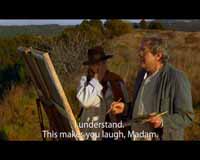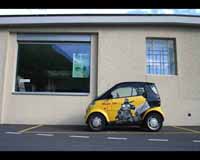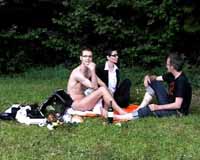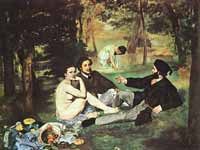home > new and ongoing > timeline > digitaler dachstock #2 > reviews
- - - <de>
code flow - events
Digitaler Dachstock #2
luncheon on the grass - postproduction by code flow
a project by code flow (Dimitrina & Alain)
17 August - 19 November 2006
at the Digitaler Dachstock of Haus für Kunst Uri
(the museum will be closed from 25 September to 20 October)
Review – Villő Huszai / clickhere.ch
This is a translation of the online review of this project at clickhere.ch:
clickhere.ch: Wilhelm Tells Reproduzierbarkeit und ein feministischer Rollentausch (in German; by Villő Huszai)
Reproducibility of Wilhelm Tell, and a feminist exchange of roles
As a second installment of the cycle "Digital Attic" in the "Haus für Kunst" in Altdorf, guest curator Martina Weber is showing two videos by "code flow". And the artists' collective immediately and aptly uses the touristic cliché of the central Swiss town for a (de-)montage via technical reproducibility.
One could be startled, arriving to the "Haus für Kunst Uri" and passing the bulky original: The Tell monument in Uri may be omnipresent in the Swiss minds, but as an image, in a much more handy format. Until next week in Altdorf, "code flow" is showing among other things the video "altdorf sightseeing tour - your guide: code flow", specially produced for the occasion. Dimitrina Sevova and Alain Kessi, the Bulgarian-Swiss collective, live in Zurich. They apply a cardinal topic of media art – reproducibility – to the good old Uri town and its stone hero: a dusty topic of our collective memory, media-artistically revived.


Two stills from code flow's video «altdorf sightseeing tour - your guide: code flow»
The video consists of two parts. It starts out with an excerpt from Michelangelo Antonioni und Wim Wenders' film «Beyond the Clouds» from 1995, in which Jeanne Moreau and Marcello Mastroianni are conversing about art and copies. «I wonder why our society needs all these copies of things. I don't mean only painting, no, but... copies of everything... even such things as clothes, suitcases, bags, watches.» This is followed by a slide show with photos of Altdorf (re-)producing a half-touristic, half-documentary view on the small town. The Tell monument is dominant – not only as a direct object in front of the camera. Indeed it is all over the place: as a graffito, as a decal picture on the body of a car, as a motif on a necktie. The visual game with reproducibility is coupled with the sound track. At first, only the exceedingly dry sound of a camera shutter comments on the chage from image to image. The final sequence however draws on the full range of exaltation and emotion available in our global audio archive.
There is something stunning about cosmopolitan media artists like Sevova and Kessi seizing such an old, familiar Swiss subject. And something of a risk – but the video is convincing. Not as the bold design, the final cut of the artists' collective, but, as one would think at first, a felicitous casual work. If one then looks at the work in conjunction with the second video, shown by Sevova and Kessi on the same large screen under the roof of the museum, it gains depth. The second video bears the title «luncheon on the grass - postproduction by code flow». It restages some sort of copy of Edouard Manet's painting «Déjeuner sur l’Herbe» from 1862 – only that in the video verson by "code flow" the intricate characteristic of nakedness falls not to a female, but to a male participant of the picnic. Indeed the copy is not always a faithful copy. The topic of reproducibility returns, but this time with a vigorous feminist twist.


Still from code flow's video «luncheon on the grass - postproduction by code flow» -
and the digital reproduction of the famous original: Manet's «Déjeuner sur l'Herbe» (Luncheon on the Grass)
The two videos achieve the impossible: To enter once more the thematic endless loop of reproducibility without boring, but rather on the contrary to mentally refresh. One part of this is that the theme of gender offensively dealt with in "luncheon on the grass" unobtrusively and indirectly changes the perception of the Tell figure; in hindsight a new light is shed on the labored masculinity of Altdorf's landmark. An attractive formal association is also given by the language mix of French, Italian and English that characterizes both videos: Mastroianni plays an Italian painter conversing in French with his interlocutor played by Jeanne Moreau, while the subtitles are held in English language. In "luncheon on the grass" an English title designates a French masterpiece, while the soundtrack accompanies the video with Pavarotti's Italian heroic tenor. Thus the mixture of languages through which globalized cultural assets are carried nowadays is reflected upon.
Sevova and Kessi are showing their works in the so-called "Digital Attic" («Digitaler Dachstock»), which is financially supported by the federal support program Sitemapping. The mini exhibition was curated by the artist Martina Weber. Before, works of the Western Swiss artists' group Collectif Fact were exhibited, and a third installment will follow as early as 23 November. With this cycle on digital art the museum is making use of a space which, according to curator Peter Stohler, has almost no daylight at all and is therefore inappropriate for white-cube exhibits. Media art as the animator of an otherwise unusable attic space? Initially this sounds markedly provincial, and so much is clear: Media art cannot be given a great stage Altdorf. But on the one hand the attic (off the beaten track, but close to the sky) is not a bad match with the genre of media art, which is leading a notorial niche existence despite many an expectation of redemption. On the other, the small media art exercise in Uri is convincing as part of a museum program that is going its own way in its main program, too. The ongoing main exhibition "Performance in Progress" tackles in a way that makes it worth seeing, a topic that is similarly challenging on the level of exhibition practices.
See also the artists' statement by code flow.